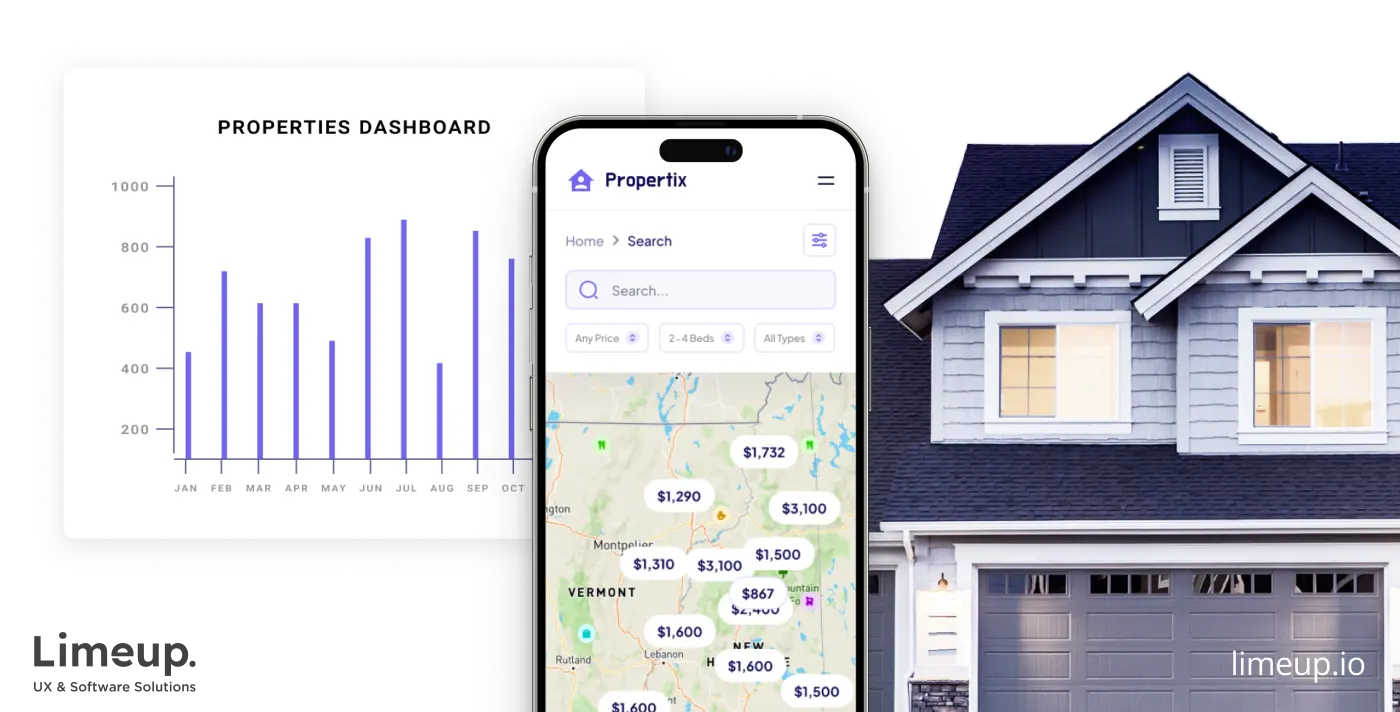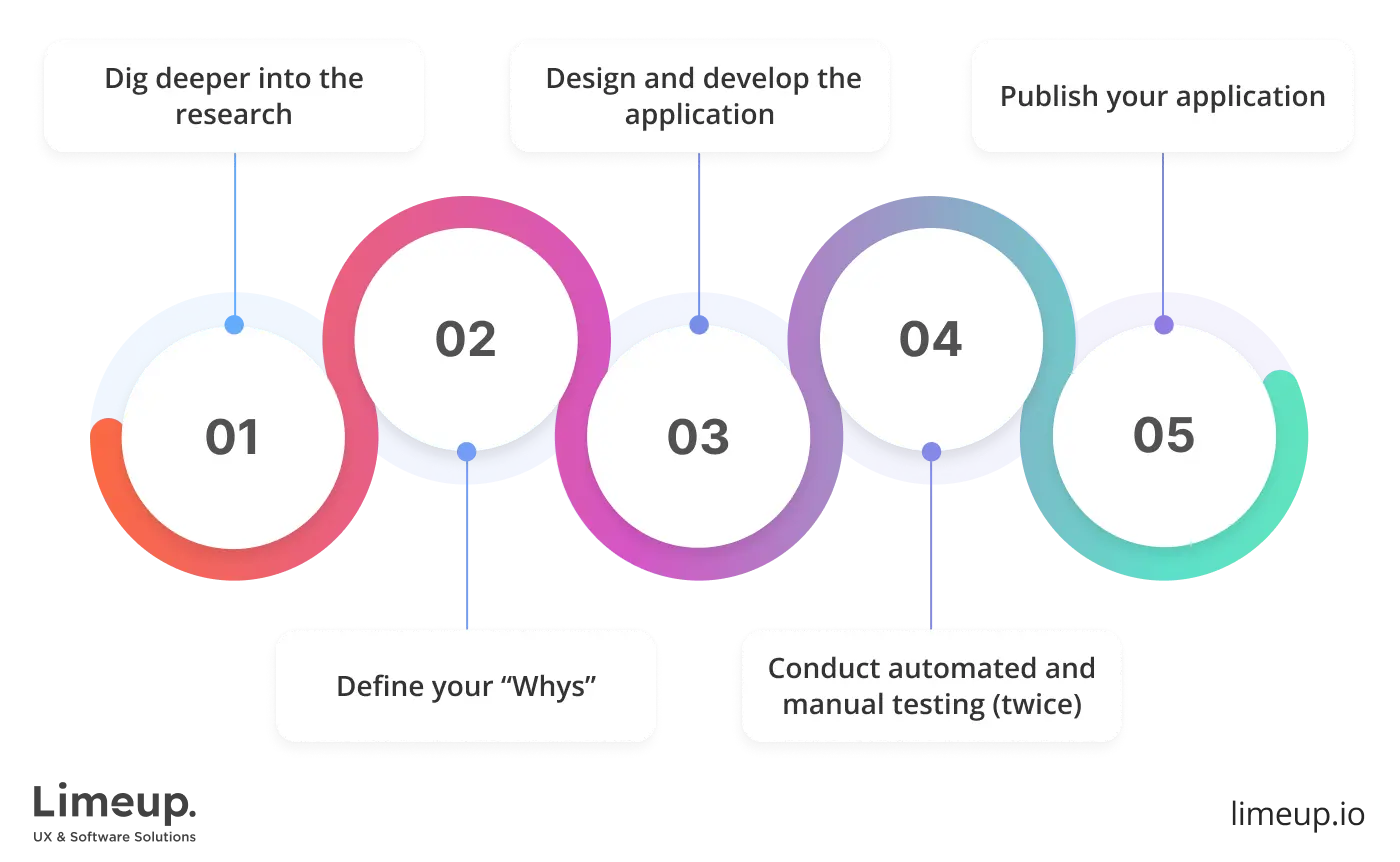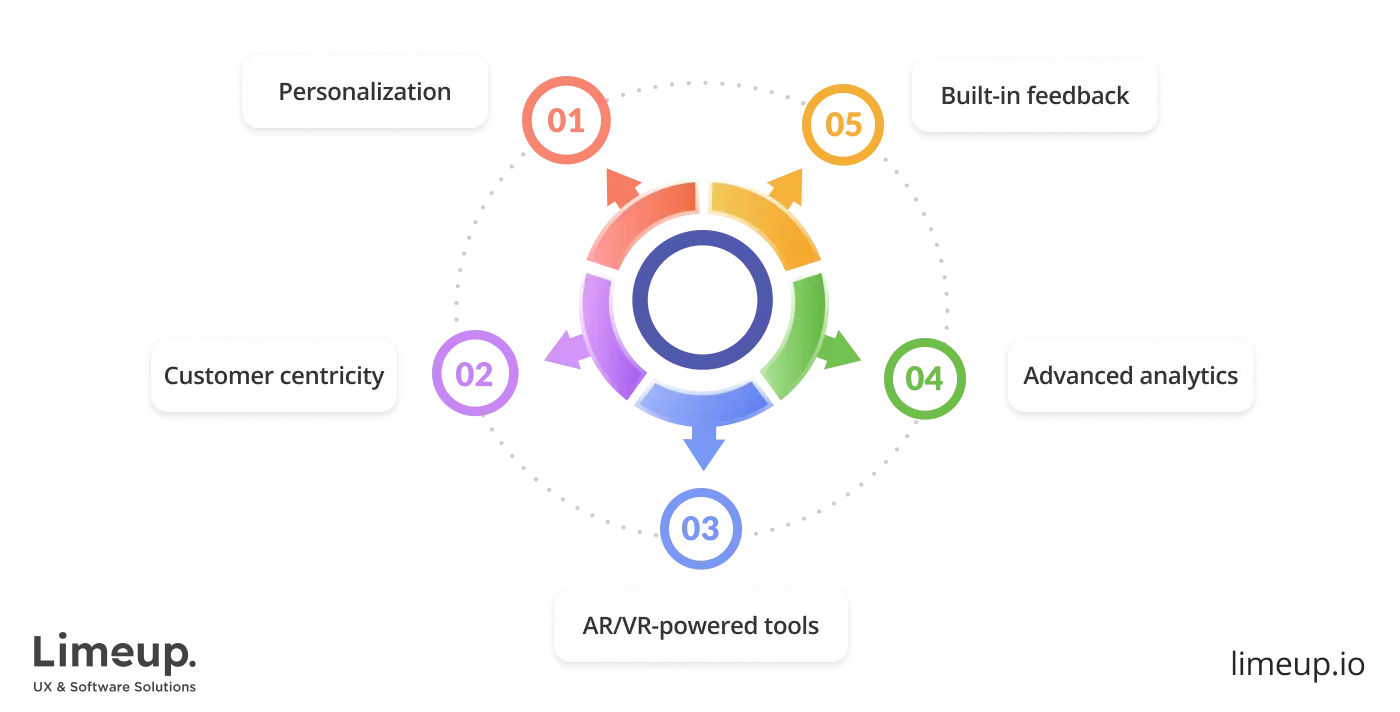How to Create a Real Estate App: Step-by-Step Overview

Real estate app development is an open sesame for businesses that would like to enhance the engagement of their clients and gain a competitive edge in the marketplace that encounters thousands of solutions. Here’s why you clocked on this brief overview, to be able to start your tech journey to increased revenue and boosted reach.
To build a real estate app that will become a profitable investment, you need to get the nitty-gritty behind the definition, 5 core stages, vital features, cost of the services, and vendors’ choosing process, which — luckily — is gathered together in this material. After reading it, you will pave the way for your application to stand out.
If you are ready to leverage our knowledge of mobile app development for real estate, let’s find out how to create one for enhanced operations and niche reach, bringing into play our 10+ years of experience in the real estate industry.
What is a real estate application?
A real estate mobile app development is dedicated to designing and creating applications for property-related businesses and landlords who want to receive a platform that will take on selling, buying, renting, managing, and trading functions, simultaneously streamlining manual procedures.

In other words, it’s a tool aimed at simplifying day-to-day operations for firms, from startups to enterprises, that can be used locally and globally according to the customer’s needs. Based on our experience, characteristically, our clients require apps for:
- property search, like the Zillow app, available for both Android and iOS,
- tokenization with responsive design, like Blockch.in,
- property management within ERP or booking system — HousePro,
- investment tools for professionals and newcomers, such as Fundrise, etc.
If you are wondering how such a niche has become digitized, we have the answer — opportunities for growth are unstoppable motivators as custom application development is a cutting-edge trend. Why? — More than half of the population has access to mobile devices and downloads applications daily, so it’s an efficient way to expand your online presence.
These years, when companies are fighting for users, app development for real estate is a VIP pass that brings to the table advantages like better communication, a vast target audience, loyalty and recognition-building practices, and more.
People need to buy and rent houses, invest, and gain profit, hoping that this issue, which sometimes feels like knocking on the devil’s door, can become a piece of cake, and here you can win them with a convenient solution.
Let’s dive deeper into the actual creation process so that you are able to start the procedure quicker and with a well-thought-out plan.
How to build a real estate app in 5 steps?
Thinking about such a project can lead you to a storming ocean of ideas where you need a straightforward navigation that will save you time and money resources. For all the new kids on the block and those who would like to gain insights about the newest trending approaches to development, we have outlined the top 5 stages that take place in our developers’ background.
There’s a reason why we decided to compile a robust explanation of each step — our consumers came to us with the same doubts:
“Will users download my app and find it helpful?”
“How can I meet their expectations?”
“Is there a way to balance quality and my budget?”
So we reveal the resolutions in this part of the article and welcome you to stay tuned and learn even more:

— Step 1. Dig deeper into the research.
Coming to any area without investigating what it breathes like means not being ready for challenges, in this case, you can’t prove that what you want to create will be in demand for years and if your audience needs it overall.
From our background, there are a few crucial points to be defined: how your competitors serve their customers, what real estate app development solutions are ranked the top, trends + challenges, and available risks.
— Step 2. Define your “Whys.”
You run an agency that takes care of rental nuances, or you are a manager helping people to select, buy, and sell their property, and you receive a task, “I don’t know what I want, but make it good.” Confusing, isn’t it? That’s how a project idea may sound if you don’t outline your requirements and purpose.
Those, you are able to determine your unique value proposition (UVP) that will differentiate you, as well as exemplify monetization strategy through premium features or ads, pain points to be covered, trending tech stack, and more.
— Step 3. Design and develop the application.
Whether you want to hire mobile app designers and coders or go on your own, it’s an essential stage that requires more time and resources, especially if you choose to build it from scratch instead of off-the-shelf production.
This phase of real estate mobile application development includes coding sessions and creative ones for a design of your choice, expanding according to your demands, for example, if you need a cross-platform product (it all determines before diving in the creation).
Note that integrations are also an option here, to put it simply, you or your provider conduct every part of system-building to be able to check the functionality and further go live with your solution. If it’s about an MVP, you create the skeleton of a future product to ensure it resonates with your customers.
— Step 4. Conduct automated and manual testing (twice).
Launching your platform without checking it wisely will lead to post-release issues as real estate application development is a complex procedure, especially for enterprises, and every code line matters. Ideally, your programmers will write thousands of functions error-free, but there’s no guarantee, so ask QAs to inspect your resolution.
If you are wondering why we wrote “twice” in this title, it’s because bug-fixing takes time, which is OK, and it’s advisable to say spending 2x time at this step will prevent money and reputation losses further.
— Step 5. Publish your application.
Here, we would like to add congratulations smile as you have done it, and the one thing is to go live+viral, creating a developer account on the App Store as an example, filling up all the information, testing it with your QA experts using “TestFlight section,” as it’s written in the guide, submit it for review and wait to be processed.
Note: the rules may vary depending on the changing requirements so it’s always good to double-check information from official websites and read/watch online guides from experienced tech gurus if you are doing it on your own.
The final system is ready to be downloaded worldwide, so you have just to maintain it well to ensure the functionality remains relevant to ever-evolving calls from your clients.
What are the features of mobile app development for real estate?
The statement of this industry in the digital era shows impressive results, for example, that 76% of people who want to buy a house use their mobile phone or tablet to search for the ideal option, so being in this space increases your chances for success.
The core question is, what functionality is vital so that you are able to win the vast % of visitors seeking a property, investors, landlords searching for a convenient management platform and more, according to your specifications? Let’s investigate the topic of building a real estate app in terms of 5 essential features that are common for every type we have named above.

- Personalization.
This function is aimed at both you and the customer, and if you are wondering how, here’s the answer — the end-user receives a tailored property recommendation that fits their needs, and you close the deal faster, shortcutting the time required for such an operation.
Actually, it’s a broad standpoint that encompasses advanced filters and smart notifications that users can adjust to their preferences, and if you are planning to have a blog with some valuable tips on trading or related, you can use dedication and propose relevant articles to your visitors.
- Customer centricity.
We have outlined in the steps that what your client wants is your priority for a successful implementation and long-term cooperation, and this term includes some other features like an intuitive interface which is essential for users who would like to receive easy access to the data.
Some businesses owners are asking how to develop a real estate app that will take place in the human’s mobile device for years to come, and we can say that the factors also involve accessibility which is evident in robust support across payments (like PayPal integration), ability to choose the native language, and even dark mode which is trending.
- AR/VR-powered tools.
No one wants to buy a pig in a poke and even adding extremely quality photos is not enough for some customers. That’s where virtual reality comes into the game with 360° views that can be followed in online mode, as well as the feature that enables modifications for furniture before applying them, for example, placing a bookshelf.
As it’s plain as the day for clients, you as a provider receive a beneficial moment of saving your time and money for face-to-face interaction in the first place, secondly comes the loyalty-building as you invested in such cutting-edge technology.
- Advanced analytics and dashboards.
A vital element that comes in handy for customers and admins and allows receiving in-depth insights into the decision-making process can’t be ignored as our specialists spent hours developing such functions and they want to share the background.
Real estate app developers behind our company have experience in creating dashboards that display recommendation, monthly and yearly reports on price, investment predictions, tracking, and more. For instance, administrators receive key results on activity and engagement, generated leads and number of deals.
- Built-in feedback tools.
24/7 communication can be applied with AI-based chatbot, yet, it’s advisable to add real conversations, especially if you are crafting an investment platform for newcomers and professionals since both of them may require help from pros.
On the other hand, being a landlord means having a few or even dozens of chats, and in-app messaging will be a game changer with the capability to save conversations in one place. Here, you can add various pop-ups, alerts, reminders about payment, and more.
It seems like a lot of work if you want to build your own real estate app but outcomes say you are on the right track, especially after familiarizing yourself with vital functions, which also will impact the final cost. We are ready to dilate on the topic in the next section, so let’s buck up and fulfill your curiosity about pricing statements, influencing nuances, and average rates for coders.
How much does real estate app development cost?
The final cost differs depending on the functionality you choose, a cross-platform solution or one system-based one you would like to receive, which level of customization is needed. We will consider these moments more so that you are armed with all required data.
If you are wondering why this question feels like a lullaby from darkness, there are a few moments to be discussed: profitability that can be reached or not reached after such a significant investment, as well as the pressure of the fintech industry which is pretty cut-throat nowadays, with prediction to reach $727.80tn by 2029.
In other words, it’s a risky yet worthy decision to create a real estate app, and to remove the psychological impact when you don’t know what you will pay for, here’s a comparison plus brief table that encompasses all crucial standpoints across the services you are able to receive or conduct by yourself.
| Factor | Cost | Overview |
| Basic app or MVP | $20,000–$49,999 | Users have the ability to (for example) access property listing, signing in, simplified interface with no dynamic elements, search filters, etc. |
| Mid-sized | $50,000–$99,999 | You provide more complex features like built-in communication tools, advanced UI/UX, analytic boards, and more. |
| Enterprise-grade | $100,000+ | There are no limits in real estate mobile app development since you are receiving a fully customizable solution. |
| Actual development | $30,000+ | This measure depends on the type of project, team location, level of coders. |
| UI/UX design | $5,000–$20,000 | Mainly it’s interconnected with the complexity, working as a symbiosis. |
| Testing | up to $30,000 | This notion was described in the how-to section, including vital code checking. |
| Ongoing support | 15-25% of total price | We have also defined the point in our guide topic above as it takes place within your provider or side programmers. |
To cover some crucial ones, let’s reflect on the developers’ location as we have done in our material about app development companies in the UK where you can overview rates for this country. For instance, the final cost will differ whether you are hiring freelancers or an agency that has a full-fledged crew of testers, software architects, designers.

On the other hand, we have mentioned compliance as a part of real estate app development services a few times which will be charged additionally, from $5,000 according to the countries you will operate in, and the provider of your choice (as well as its experience in such industry).
What can’t be skipped is the technologies to be used, as of them are rare, where you need to pay more hourly as such coders are busy with other related products. If you are into iOS real estate app development, then Swift programmers are a perfect match, they are widely available on the market.
How to select a real estate app development company?
Teaming up with a trustworthy agency is a VIP pass in the world of application that changes the game, and if you are asking why, here’s a simple answer that skilled teams can handle any challenges. The moment is in selecting a proper one if you decide to go this way, so here are our tips, just a few one, for those who are ready to cooperate or think about collaboration with a vendor:

- Elevate its know-how within the services delivered and case studies that are usually represented on the website, with details, key results, tech stack used, for example, if you need Flutter app development for real estate as you pre-defined in the requirements.
- Check communication as you will work with a provider for months, and it’s advisable to discuss what updates you would like to receive, how the staff reacts to changing needs, and so on.
- Investigate the cooperation model as when you choose to hire app developers who are used to working in a crew, they typically have a well-established plan — dedicated team, long-term cooperation, group extension, and more.
We have named a few of the essential ones that are common for every type of project you need, so now you are fully aware of every nitty-gritty behind this concept.
Summing up
Such expert guidance leads you to the final point where you are able to start the developing process and start winning the cut-throat real estate market, as you can feel that understanding the nuances is like deciphering an ancient script with a modern translation.
We have considered crucial 5 stages in the “how-to section,” reveal the nitty-gritty behind core features, and even fully disclosed the pricing which feels like a cold breath on a warm neck, which is a lot of work that went great.
Are you ready to take the next step with a reliable company? Contact Limeup for a free-of-charge consultation, during which we will discuss your needs and define all details for productive collaboration.

